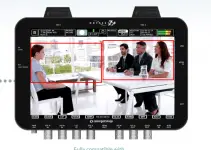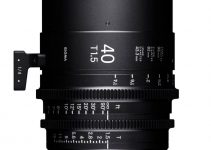RED has never been known for their budget-friendly camera systems. Even their early “affordable” models only referred to base costs for the brain and didn’t include all the other bits and pieces you needed to buy separately – and this includes key components like a monitor that didn’t come with it. The RED KOMODO 6K is changing that narrative, but realistically you are still going to want to pick up some extra tools to make the most of it.
Being one of the newest Netflix-approved cinema cameras, what type of equipment are you looking at to build an appropriate Netflix-ready kit? Filmmaker Carlos Quintero got his hands on a KOMODO and put together a package – as well as its real cost.
We have to start by pointing out that the KOMODO is perfectly usable after purchase by just attaching a lens and popping in some media. It has a touchscreen, some inputs, and all that you really need to get started. This compact body alone costs ~$5,995. Quintero takes the stance that this camera is actually closer to $10,000 when you add on the accessories.
He is going to look at two builds for the camera: one that is a barebones setup and the other is designed for professional productions. Keep in mind, these are not all required items, but they should help improve productivity and efficiency on set.
Assuming you are starting from scratch, the first thing to add to the $6k camera is media. The KOMODO takes CFast 2.0 cards and with REDCODE RAW you’ll want bigger options and a couple of them.
Right now, RED media (made by Angelbird) is $529 for 512GB cards. Barebones you’ll need two, for a total of $1,058 and for production you are looking at five at least for $2,645. Plus don’t forget a card reader for $110. That definitely adds a tax to the camera.
Being such a tiny camera, you actually don’t have all the pro connections you may need. One key example is traditional timecode in. RED produced the KOMODO Expander Module specifically to address this and it adds Genlock, GPI, timecode in, and CTRL connections. On top of this, the RED EXT-to-Timecode Cable will run you another $110. You’ll essentially need to pick this up for serious workflows.
We haven’t even gotten to a timecode generator solution. Quintero recommends the Tentacle Sync E as a capable, compact option that will run you $399.Powering your camera is an all-important matter, and the KOMODO, fortunately, uses some common options: Canon BP-9 series battery packs. There are two slots on the back – which are hot-swappable – and you’ll want a pair for longer shooting times.
BLUESHAPE sounds like Quintero’s pick here and for the barebones two-pack of BP-975 batteries, you’ll need to spend $278 (or ($139 each). Productions with long shooting days and requirements to have backups will be spending a lot more. Quintero thinks about six at least, which means $834. And… the charger which is going to run about $103.
Next up is a way to transform the compact 4 x 4 x 4” box into something more comfortable to use. That is easily solved by RED’s Outrigger Handle. Not only is it a well-designed grip for the KOMODO, it actually has a stop/start recording button that is a nice quality of life upgrade. That’ll run you $475.
Audio, audio, audio. With no built-in XLR connections, you’ll want something more serious to handle audio. As for that, you could opt for a dedicated recorder like the MixPre series from Sound Devices, or go with something a little more affordable that goes right into the camera, such as the Beachtek DXA-RED 2-channel preamp for RED cameras. It’s a nice solution for adding professional audio inputs. That’s another $499.
One thing the KOMODO lacks due to its size is an internal ND filter system. Many people may want to go with simple screw-in type filters, but the best for the KOMODO and its RF mount is going with Canon’s special adapter with built-in ND filter.
Sure, you are limited to just EF lenses, but there are tons of excellent options there and you still maintain AF support with this adapter. This certainly isn’t cheap at $399. Going with matte boxes instead will add a lot more cost and size.
While the KOMODO does have a screen on it, this is far from what you might want for monitoring critical shots. Now, there is also an app to preview using a phone but that isn’t what you want either.
Quintero’s choice for a monitor is the solid SmallHD FOCUS Pro, which has the SDI input you need and a beautiful screen. The other reason for this model is that with an additional upgrade you can pick it up with the KOMODO Control Kit for controlling camera settings via the FOCUS Pro monitor. The base monitor, fine for the barebones rig, runs $699, and the control kit will tack on another $250. And you’ll need a couple basic batteries which are relatively affordable.
Now, some of these accessories you might find cheaper from other manufacturers, so this isn’t a perfect estimate, but it should show that there is a significant investment to be made regardless. Also, Quintero opts for RED-branded items a lot of the time to guarantee compatibility which also leads to larger costs. And, he is choosing the cheaper options in a lot of cases, not necessarily what you will pick.
Anyway, the final totals are $10,779 for the barebones kit and $13,233 for the production kit. That’s a lot more than the ~$6k price tag would let on. Sure, some shooters might be able to trim this down a bit, but I still think most will end up spending a couple thousand just to get it to a preferred setup.
Would looking at this make you reconsider picking up a RED KOMODO for yourself? Or is this similar to what you would get with any camera?
[source: Carlos Quintero]
Order Links:
- RED KOMODO 6K Cinema Camera (B&H)
- 512GB RED PRO CFast 2.0 Memory Card (B&H)
- RED CFAST 2.0 Card Reader (B&H)
- RED KOMODO Expander Module (B&H)
- RED EXT-to-Timecode Cable (B&H)
- Tentacle Sync E Timecode Generator (B&H, Amazon)
- BLUESHAPE Canon BP-975 Battery Pack (B&H)
- BLUESHAPE CMDual Base Charger Kit (B&H)
- RED KOMODO Outrigger Handle (B&H)
- Beachtek DXA-RED 2-Channel Preamplifier (B&H)
- Canon EF-EOS R Drop-In Filter Mount Adapter with Variable ND (B&H, Amazon)
- SmallHD FOCUS Pro OLED 3G-SDI Monitor (B&H, Amazon)
- SmallHD FOCUS Pro OLED 3G-SDI Monitor with KOMODO Control Kit (B&H, Amazon)
Disclaimer: As an Amazon Associate partner and participant in B&H and Adorama Affiliate programmes, we earn a small comission from each purchase made through the affiliate links listed above at no additional cost to you.
Claim your copy of DAVINCI RESOLVE - SIMPLIFIED COURSE with 50% off! Get Instant Access!




